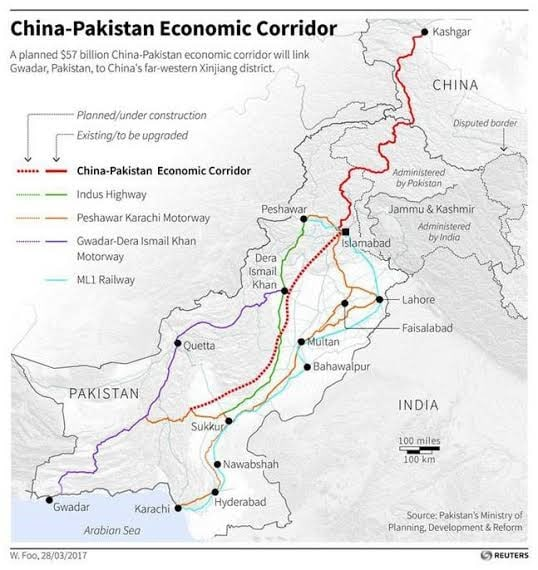CURRENT AFFAIRS
Get the most updated and recent current affair content on Padhaikaro.com
China-Pakistan Economic Corridor (CPEC)
- Vaid's ICS, Lucknow
- 09, Feb 2022

G.S. II
Topics Covered: India and neighbours.
Context:
China and Pakistan have signed a new agreement on industrial cooperation as part of the China Pakistan Economic Corridor (CPEC) plan.
- The industrial cooperation agreement is a key part of what is being called “phase two” of CPEC.
- The first phase primarily involved Chinese investments in energy projects as well as road infrastructure.
About CPEC:
Launched in 2015, the CPEC is the flagship project of the multi-billion-dollar Belt and Road Initiative (BRI), a pet project of Chinese President Xi Jinping, aimed at enhancing Beijing’s influence around the world through China-funded infrastructure projects.
- The 3,000 km-long China–Pakistan Economic Corridor (CPEC) consists of highways, railways, and pipelines.
- CPEC eventually aims at linking the city of Gwadar in South Western Pakistan to China’s North Western region Xinjiang through a vast network of highways and railways.
- The proposed project will be financed by heavily-subsidised loans, that will be disbursed to the Government of Pakistan by Chinese banks.

CPEC is getting increasingly unmanageable with local Pakistanis unhappy with the Chinese soldiers and civilians working on the project. Therefore, Pakistan has been forced to deploy more soldiers in the area.
Why is India concerned?
It passes through PoK.
- CPEC rests on a Chinese plan to secure and shorten its supply lines through Gwadar with an enhanced presence in the Indian Ocean. Hence, it is widely believed that upon CPEC’s fruition, an extensive Chinese presence will undermine India’s influence in the Indian Ocean.
- It is also being contended that if CPEC were to successfully transform the Pakistan economy that could be a “red rag” for India which will remain at the receiving end of a wealthier and stronger Pakistan.
- Besides, India shares a great deal of trust deficit with China and Pakistan and has a history of conflict with both. As a result, even though suggestions to re-approach the project pragmatically have been made, no advocate has overruled the principle strands of contention that continue to mar India’s equations with China and Pakistan.
Facts for Prelims
Sentinel on the qui vive
Sentinel on the qui vive is usually translated as watchful guardian. Qui vive means watchful or alert.
- Supreme Court recognized this phrase in State of Madras v. VG Row. Union of India & State (1952), where the Court has been given the role of “Sentinel on the Qui Vive” with regards to the “fundamental rights”.
Major non-NATO ally (MNNA)
US has designated Qatar a MNNA.
What is a MNNA?
- It is a designation given by the United States government to close allies that have strategic working relationships with the US Armed Forces but are not members of the North Atlantic Treaty Organization (NATO).
- Nations with MNNA designation are eligible to, among other things, host U.S. war reserve stockpiles of material inside their countries.
- While MNNA status provides military and economic privileges, it does not entail any commitments to the designated country.
- India is not a MNNA of US.